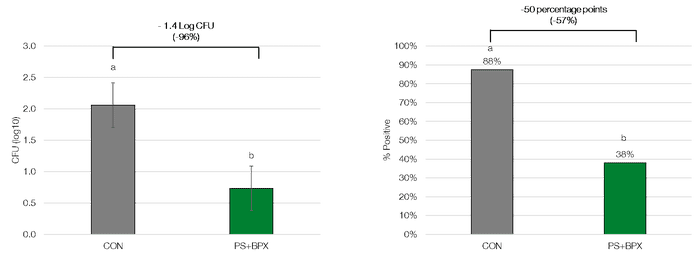Strategy to mitigate food safety risk in broiler production
An in-feed application of a synbiotic followed by an enhanced organic acid demonstrated to effectively manage food safety risks like Salmonella.
July 23, 2020

Sponsored Content
Food safety is a key topic when it comes to commercial poultry production and over recent years, this topic has quickly established itself at the forefront of media outlets, research, and government regulations. The main concern related to Salmonella is that poultry meat and eggs are noted as the most common sources of human infection, while birds can be infected yet show no signs of disease.
The complete eradication of Salmonella from poultry production is an incredibly difficult goal. Applying a combination of strategies including proper management, biosecurity, vaccination protocols, nutritional feed additives, and research are steps in the right direction. Moreover, as producers shift away from usage of antibiotics, industry leaders and researchers are actively searching for additional tools to assist in managing food safety risks. Probiotics, prebiotics, and organic acids have been considered potential options as they have been shown to limit the growth of several enteric bacterial pathogens and improve overall gut health.
A series of trials have been conducted on two feed additives, PoultryStar® and Biotronic®, evaluating their efficacy in reducing Salmonella load in challenged broilers. PoultryStar® is a well-defined, multi-species synbiotic (combination of probiotics and prebiotic), known to promote beneficial gut microbiota through the combined action of direct-fed microbial organisms and prebiotic fructooligosaccharide. Biotronic® is an enhanced organic acid feed additive consisting of a combination of sodium formate, cinnamaldehyde and Biomin® Permeabilizing Complex.
During one study conducted at the University of Georgia, carcass Salmonella contamination was significantly reduced due to PoultryStar supplementation by 1.5 log units (-97%; Shanmugasundaram et al., 2019) compared with the control birds. In another trial conducted at the same university, Biotronic supplementation was able to significantly reduce Salmonella load of carcass rinsates by 1.7 log units (-98%; Curry et al., 2019).
With a similar objective, but with the idea to come up with an effective mitigation program in commercially grown broilers, a feeding trial was conducted at Texas A&M University to evaluate the effects of combined program of PoultryStar followed by Biotronic on performance and cecal and carcass Salmonella load (Pender et al., 2020). A total of 288, day-old Cobb 700 male chicks were allocated to one of two treatment groups: a control group provided with a standard basal diet or a treatment group provided with a diet supplemented with PoultryStar (500g/MT) in the starter (0-14 days) and grower (15-28 days) phases, and Biotronic (500g/MT) in the finisher (29-42 days) phase. Each group consisted of 8 replicate pens with 18 birds/pen and the trial was conducted over a 42-day period from day of hatch.
Body weight was increased throughout the trial and overall body weight was significantly improved in the supplemented group by 119g (Figure 1). In general, feed intake was increased in birds in the supplemented group with an overall numerical increase of 78g (Figure 1). Feed conversion was improved by -0.05 FCR points during the overall period compared to the control (Figure 2).
Figure 1. Effect of a program consisting of PoultryStar® (PS) and Biotronic® (BPX) on body weight and feed intake.

Figure 2. Effect of a program consisting of PoultryStar® (PS) and Biotronic® (BPX) on feed conversion.

Though not statistically significant, the percentage of ceca that were positive for Salmonella in the supplemented group was reduced by 12 percentage points (-24%) at 38% compared to the control’s 50%. When looking at Salmonella load of the carcasses, the group provided the feed additive program displayed reduced carcass Salmonella load by 1.4 log units (-96%) compared with the control birds (Figure 3) and the percentage of carcasses that were positive for Salmonella in the supplemented group was also significantly reduced by 50 percentage points (-57%) (Figure 4).
Figures 3 and 4. Effect of a program consisting of PoultryStar® (PS) and Biotronic® (BPX) on carcass Salmonella load.

Overall, the data from the study at Texas A&M University, along with the above-mentioned studies conducted at the University of Georgia, indicate that a feed additive program consisting of supplementation with the poultry-specific multi-strain live synbiotic, PoultryStar, followed by the enhanced organic acid, Biotronic, was a valuable strategy to help reduce carcass Salmonella contamination while increasing broiler performance.
References:
Curry, S., R. Shanmugasundaram, M. Mortada, D. E. Cosby, M. Singh, T. J. Applegate, B. Syed, C. M. Pender, G. R. Murugesan, and R. K. Selvaraj (2019) Dietary inclusion of enhanced organic acid improve performance and reduced carcass contamination in broilers challenged with Salmonella enteritis. Annual Poultry Science Association Meeting. Montreal, Quebec. July 15-18. Poult. Sci. 98 (E-Suppl. 1), pp120-121.
Pender, C., S. Ramirez, G.R. Murugesan, E. Sobotik, and G. Archer (2020) Effects of a synbiotic or synbiotic plus enhanced organic acid program on broiler performance and cecal and carcass Salmonella load . International Poultry Scientific Forum, Atlanta, GA. January 27-28. Poult. Sci. 99 (E-Suppl. 1) pp42.
Shanmugasundaram, R., M. Mortada, D. E. Cosby, M. Singh, T. J. Applegate, B. Syed, C. M. Pender, S. Curry, G. R. Murugesan, and R. K. Selvaraj. 2019. Synbiotic supplementation to decrease Salmonella colonization in the intestine and carcass contamination in broiler birds. PLOS One 14 (10):e0223577.
About the Author(s)
You May Also Like



